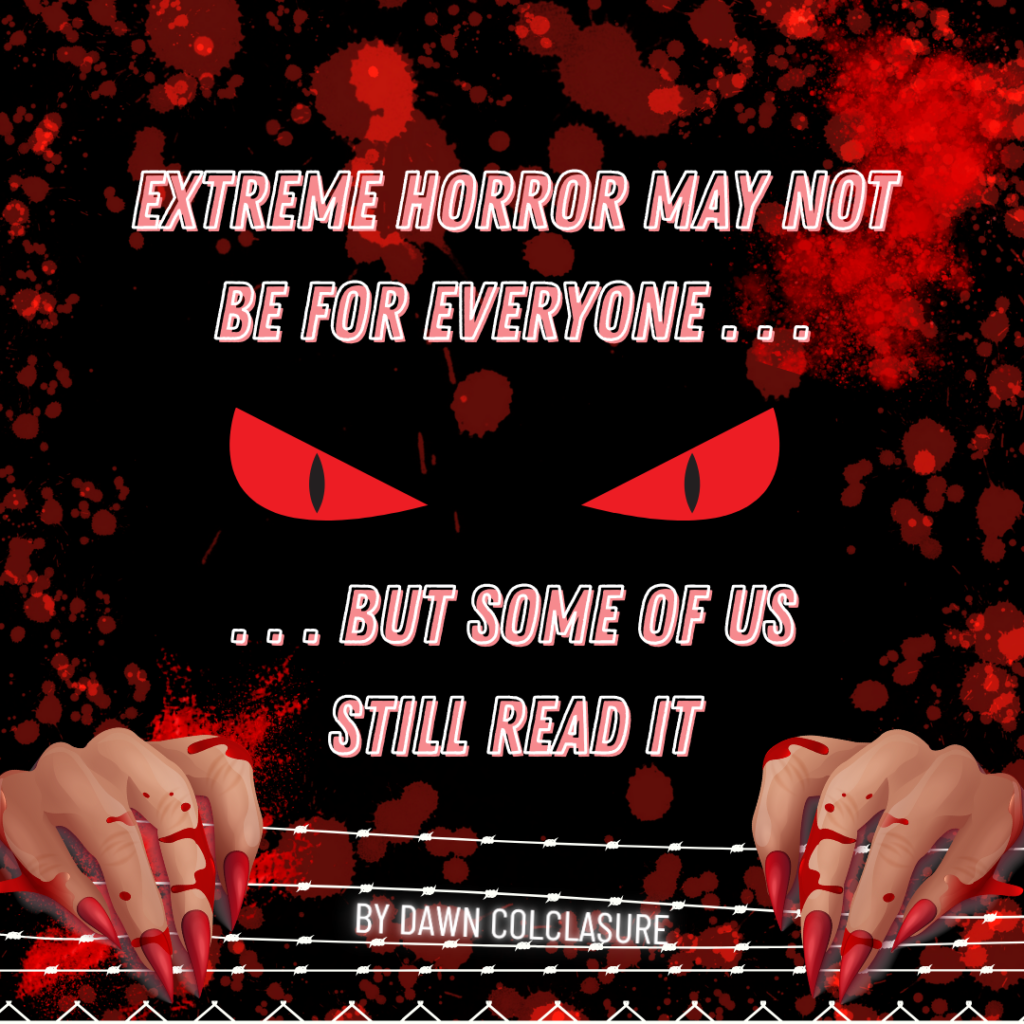One of the reasons why a lot of people avoid books and movies that are “horror” is because there’s a misconception that there is only one type of horror: extreme. These are the kinds of horror that seem to go overboard with the gore and grossness, such as cannibalism and graphic descriptions of dead bodies. Extreme horror is starting to be seen in a negative light, so many publishers are shifting gears, opting instead to publish “light horror” or something similar to what is safe for children.
Nevertheless, there is still a market for extreme horror. And there are still people out there willing to read it.
This isn’t to say that those of us who enjoy reading extreme forms of horror are unaffected by the grim reality of death and destruction. On the contrary, most of us are indeed affected by what’s happening in the world and on the news and cluttering our social media feeds, even if we do not make how we feel about wars and political turmoil publicly known. This is to say that our enjoyment of reading extreme horror does not affect the way we perceive real-life horror, because we know that the stories we are reading are, ultimately, works of fiction. We understand that people are not really getting hurt, chopped to pieces, or being feasted on by cannibals. The stories will end. The nightmare will stop and the masks will be removed from the actors residing in our minds.
Yet for those of us who enjoy reading extreme horror, the experience is not really a nightmare per se. It’s more like a movie playing in our heads. Just as some horror fans relax by watching scary movies, horror readers find release and escapism reading scary novels, especially if the scares are extreme.
In most cases, extreme horror captures what horror is all about: the darker side of life and humanity. These stories are just more of the same things we are already dealing with in our own lives. And while we know revenge is bad, some readers of extreme horror may be picturing their evil boss as the target that gets decapitated, or the high school bully as the person stabbed to death, and this can offer a sense of satisfaction. Of course we would never do such a thing to these people, but vicariously witnessing it through the stories we read is cathartic—an alternative to paying for an actual therapy session to deal with those issues.
One other factor about extreme horror is that it is similar to real-life horrors we have already witnessed. Sadly, there are parents who have murdered their children, stepparents molesting stepchildren, and killers on the loose committing heinous and bloody crimes. There are real monsters out there in the world, and reading extreme horror gives us the strength we need in dealing with the monsters we’ve faced.
For some writers of extreme horror, putting our trauma into our stories helps us to not only cope with it but let it go. By taking the horrible thing we experienced out of our head and putting it into a story, we are ultimately freeing ourselves from it.
One may argue that there should be less extreme horror because of all of the real-life horror going on in the world. However, for some readers and writers of extreme horror, the intensity of the scares and gruesomeness in the story can help us better adjust to the horrors of real life—all those things which we can do nothing about (short of writing to our representatives to plead for stricter gun laws and background checks).
In a blog post titled “Responding quietly to the roar at extreme horror fiction,” writer Lydia Peever counters many arguments against extreme horror. One such argument is that extreme horror may encourage impressionable readers to commit crimes. “Extreme fiction, and to a larger degree splatterpunk, draw a lot of their inspiration for storylines, plots, and characters from real life—from the news and from what is going on around the readers or what has happened in their past and impacted them, their loved ones, or people they know. Therefore, the storylines are often of a darker nature, quite grim, and true to life. … [But] if a reader is having a hard time distinguishing fiction from reality, there’s a larger problem at play, and they should be seeking professional help or speaking with people they know and trust about this particular issue. This is not caused by, nor should it be the concern of, artists whose art they consume.”
Indeed, it is not the responsibility of writers to hold the hands of their readers and keep them away from the terrible monsters that might tempt their worst selves. This is where content warnings come into play. The responsibility of a writer is to entertain, and extreme horror is just one form of entertainment.
Finally, in some small way, exposing ourselves to extreme horror—whether through movies or books—helps us harden ourselves against the extreme horror of real life. It’s not the same as being desensitized to real-life horror, because we understand that real people are facing real terrors. What it does is imbue us with the ability to withstand the cruelties we must endure in order to make it to the end. Facing imaginary monsters gives us the tools we need to conquer real-life monsters. In a world that seems to be in constant tumult, we could use more of that courage and endurance.

